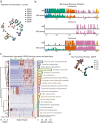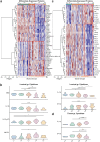Distinct cervical tissue-adherent and luminal microbiome communities correlate with mucosal host gene expression and protein levels in Kenyan sex workers
- PMID: 37004130
- PMCID: PMC10064689
- DOI: 10.1186/s40168-023-01502-4
Distinct cervical tissue-adherent and luminal microbiome communities correlate with mucosal host gene expression and protein levels in Kenyan sex workers
Abstract
Background: The majority of studies characterizing female genital tract microbiota have focused on luminal organisms, while the presence and impact of tissue-adherent ectocervical microbiota remain incompletely understood. Studies of luminal and tissue-associated bacteria in the gastrointestinal tract suggest that these communities may have distinct roles in health and disease. Here, we performed a multi-omics characterization of paired luminal and tissue samples collected from a cohort of Kenyan female sex workers.
Results: We identified a tissue-adherent bacterial microbiome, with a higher alpha diversity than the luminal microbiome, in which dominant genera overall included Gardnerella and Lactobacillus, followed by Prevotella, Atopobium, and Sneathia. About half of the L. iners-dominated luminal samples had a corresponding Gardnerella-dominated tissue microbiome. Broadly, the tissue-adherent microbiome was associated with fewer differentially expressed host genes than the luminal microbiome. Gene set enrichment analysis revealed that L. crispatus-dominated tissue-adherent communities were associated with protein translation and antimicrobial activity, whereas a highly diverse microbial community was associated with epithelial remodeling and pro-inflammatory pathways. Tissue-adherent communities dominated by L. iners and Gardnerella were associated with lower host transcriptional activity. Tissue-adherent microbiomes dominated by Lactobacillus and Gardnerella correlated with host protein profiles associated with epithelial barrier stability, although with a more pro-inflammatory profile for the Gardnerella-dominated microbiome group. Tissue samples with a highly diverse composition had a protein profile representing cell proliferation and pro-inflammatory activity.
Conclusion: We identified ectocervical tissue-adherent bacterial communities in all study participants of a female sex worker cohort. These communities were distinct from cervicovaginal luminal microbiota in a significant proportion of individuals. We further revealed that bacterial communities at both sites correlated with distinct host gene expression and protein levels. The tissue-adherent bacterial community could possibly act as a reservoir that seed the lumen with less optimal, non-Lactobacillus, bacteria. Video Abstract.
Keywords: 16S rRNA gene; Biofilm; Cervix; Ectocervix; Luminal; Microbiota; Protein profiling; Tissue; Tissue-adherent; Transcriptomics.
© 2023. The Author(s).
Conflict of interest statement
The authors declare no competing interests.
Figures






References
-
- Callahan BJ, DiGiulio DB, Aliaga Goltsman DS, Sun CL, Costello EK, Jeganathan P, et al. Replication and refinement of a vaginal microbial signature of preterm birth in two racially distinct cohorts of US women. Proc Natl Acad Sci U S A. 2017;114:9966–9971. doi: 10.1073/pnas.1705899114. - DOI - PMC - PubMed
-
- Low N, Chersich MF, Schmidlin K, Egger M, Francis SC, van de Wijgert JHHM, et al. Intravaginal practices, bacterial vaginosis, and HIV infection in women: individual participant data meta-analysis. PLoS Med. 2011;8 [cited 2022 Jan 12]. Available from: https://pubmed.ncbi.nlm.nih.gov/21358808/. - PMC - PubMed
-
- Borgdorff H, Tsivtsivadze E, Verhelst R, Marzorati M, Jurriaans S, Ndayisaba GF, et al. Lactobacillus-dominated cervicovaginal microbiota associated with reduced HIV/STI prevalence and genital HIV viral load in African women. ISME J. 2014;8:1781–1793. doi: 10.1038/ismej.2014.26. - DOI - PMC - PubMed
Publication types
MeSH terms
Substances
LinkOut - more resources
Full Text Sources
Molecular Biology Databases

